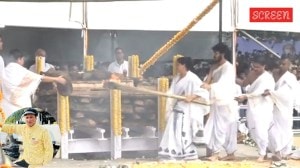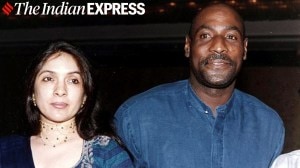Kings of Hearts
‘‘Time?’’ Dr Balram Airan barks out the question. ‘‘19 minutes,’’ says the technician watching the c...

‘‘Time?’’
Dr Balram Airan barks out the question.
‘‘19 minutes,’’ says the technician watching the clock.
It’s 10:40 am in the chill, sterile air of OT (operation theatre) 4. Dr Airan, 59, quickens the pace of the surgery. There are just 11 minutes left before Suresh Narela’s stilled heart will show signs of life. His body’s blood-pumping nerve centre has been stopped, its functions transferred to a softly whirring Rs 50 lakh heart-lung machine, its temperature lowered to about nine degrees below the normal 37 deg C to stop the deterioration of tissues.
Of course, Dr Airan can show just so much urgency. Narela’s chest has been carefully split wide open with an electric saw and held apart by steel clamps. But Narela, from the town of Balti Sagar in Madhya Pradesh, is only six years old. Working amid the maze of blood vessels and muscles in his small chest is a test of skill and nerve. So goading a team of eight doctors, nurses and technicians, Dr Airan cuts, reroutes vessels and sutures as fast as he possibly can. On his nose are magnifying glasses, and on his forehead a concentrated beam of high-powered xenon light — fed by a fibreoptic cable that snakes under the back of his surgical tunic and out — illuminates the mess of arteries, veins, skin, the stopped heart and a maze of sutures.
A resident trying his hand at a suture fumbles every so slightly. Dr Airan flares up.
‘‘Can’t you do a suture right? I’ll do it!’’
SHORT tempers are normal when you’re doing such complex surgeries six days a week (seven if there’s an emergency), morning and afternoon. Narela’s heart was working at just 14 per cent when the surgery began. He’s undergoing a total cavopulmonary connection, one of about 500 done at AIIMS so far. The veins and arteries carrying impure and pure blood to and from his heart’s four chambers are mixed up — and to complicate matters, the heart has a hole.
Every year, about 3,000 open-heart surgeries are performed at the seven OTs at the Department of Cardio Thoracic and Vascular Surgery (CTVS) at the All India Institute of Medical Sciences, New Delhi. Dr Airan is one of three professors at the CTVS. In popular wisdom, the heart is the seat of the soul, the source of courage and love. To the medical practitioner, the heart is a pump, no more than a slave of the brain. Still, open-heart procedures, because of their complexity, are often considered surgery’s gold standard.
| AIIMS was the first hospital —and is only one of the three institutions — in India that will do a heart transplant. Of the 35 transplants done in the country, 16 have been done here since 1994 |
| Dr P Venugopal: ‘There were always opportunities to move to greener pastures but I had commitments to this place’ |
There is no greater number, no greater variety of cardiac surgery done anywhere else in India. This was the first hospital — and is only one of three institutions — in India that will do a heart transplant. Of 35 heart transplants done in India, 16 have been at the CTVS since 1994. No one is refused, even if it’s an ailing six-month-old infant with a 10 per cent chance of survival, cases that are typically refused by private hospitals concerned about their mortality and morbidity rate. The youngest patient in ICU ‘A’ today is a 46-day-old baby. The intense pressure on these surgeons will only increase, thanks to the grim rise in India’s coronary heart disease statistics. Indians have a greater genetic predilection for heart disease than any other race in the world. Sedentary lifestyles and bad food habits only heighten the risk across all age groups. In 1980, coronary bypass surgery made up less than 10 per cent of a cardiac surgeon’s work. Today, it is more than 60 per cent.
‘‘I have no interest in talking to you. I don’t want publicity.’’
The grim voice at the other end of the line belongs to Panangipalli Venugopal, 59, Airan’s boss and Chief, CTVS. ‘‘Chief saab’’ as he’s known in the corridors of AIIMS’ eight-storey Cardio Thoracic and Neuro Sciences Centre, is an institution by himself here — but he would rather you not mention it.
It takes considerable persuasion before he agrees to a meeting. Dr Venugopal is laconic, terse and does not offer trust easily. The suspicion is understandable, given the rush to see him. But they must all huddle barefoot beyond the swing doors of ICU (intensive care unit) A, and wait to spot him at his room down the sterile corridor.
Today there’s a retired Supreme Court justice and his wife ushered in as VIPs but still waiting outside his room. Dr Venugopal’s reputation precedes him. ‘‘I do not mind being admitted anywhere, doctor,’’ the justice says humbly with folded hands. ‘‘I will go to any ward that you say.’’ No one who makes it through these swing doors is ever refused the ‘‘chief’s’’ attention.
Yet, Venugopal finds the time to visit each of his patients. ‘‘In private hospitals you don’t see the doctor again,’’ says Group Captain (retd.) Chaudhary, an industrial consultant. ‘‘He’s visited me every day.’’ Chaudhary’s nephew is a doctor at Escorts, but after a previous operation 14 years ago, he will go nowhere else. He’s in a private room paying Rs 1,800 a day. ‘‘I have developed faith in the system here.’’
| In the three decades since he set up the Cardio Thoracic and Neuro Sciences Centre at AIIMS, Dr Venugopal has been associated with 22,000 open heart surgeries |
It’s a system strained by incredible pressures. The line at the out patients department is already 50 deep, 15 minutes before registration opens at 8 am. Tired, many squat on the ground, using their papers to shade themselves from a sun that is just warming up. When the doctors are done with their surgeries — many residents work for 36 hours at a stretch — they do OPD duty in the evenings, struggling to their offices through the throngs. They come in from every corner of the country, but particularly from Bihar and Uttar Pradesh. In contrast to the national annual average of 42 open-heart surgeries per million population — itself inadequate when you consider the U.S. with a lesser disease burden does 1700 per million — cow-belt hospitals do no more than three open-heart surgeries per million. And there’s one thing they don’t command: faith.
K.V.S.R.N. Acharya, vermillion on his forehead, is talking about the failed prayers for his niece, V. Sridevi, 24. She’s a superlight 27 kg, her body wasted away by an abnormal heart. It’s congenital, the result of a genetic coding mistake made in the blueprint of her life. Acharya spends the day under the plastic awning outside the CN centre where the families of patients under surgery huddle. Sridevi lies in ICU ‘A’, recovering from a stamp-size plastic patch that Dr Venugopal himself wove to cover the hole in her heart. In time, she will gain weight and live the normal life she is unfamiliar with.
Sridevi’s husband too is a priest in Rajahmundhry, Andhra Pradesh. Between his salary and pilgrim donations, he makes Rs 2,300 a month. Acharya, the secretary of the state purohit (priest) association, talks in hushed tones of Venugopal. “We performed pujas to a god who would not talk to us. But he (Venugopal) spoke to us and gave us his blessings.”
It is an emotion understood only by those who see release from years of suffering. A heart surgery at AIIMS is not free, but a surgery that costs Rs 50,000 here will go for Rs 5 lakh a private hospital. It may not have their spit and polish, their celebrity surgeons, but it certainly has equipment — Rs 1 crore worth in each OT — and skills that are the best in the land.
There are excellent charitable hospitals, especially in the south, that will do some open-heart surgeries, but the waiting lists can stretch to five years. Like the Super Speciality hospital — set up under Venugopal’s supervision incidentally — in Puttaparthi, where Sridevi was taken. But after four years of waiting, her condition deteriorated and her family pooled money to bring her to AIIMS, which has a three-month waitlist. There are patients so poor that they even want a waiver on the admission charge of Rs 35. Acharya, a priest at a Sri Ram temple, is now emotional. “Sri Rama,” he whispers, “sent us to Sri Krishna. We perform the poojas, but here we have seen the real gods.”
Such words embarrass Venugopal, but in the three decades in which he set up the this centre and been associated with more than 22,000 open-heart surgeries, the diminutive surgeon’s strong, brooding presence is unmistakable. ‘‘He’s a ‘Yes Boss!’ kind of a man,’’ smiles Sister Kulwant Saxena, a 20-year veteran who remembers praying fervently when the first heart transplant got underway. ‘‘He’s so energetic, and he knows how to get things done.’’ It’s a reference to Venugopal’s ability to create a world-class institution under the aegis of the government. Saxena is one of many so involved with the growth of the Centre that she never really seriously considered moving to the lucrative private sector. ‘‘When you put your heart and soul into something…’’ her voice trails off.
Venugopal, who trained under legendary heart surgeon Denton Cooley at the Texas Heart Institute in 1972, knows the feeling of life passing by when you’re building something lasting. He married late — his daughter is only five — and he’s seen many of his students leave for greener pastures. ‘‘There were always opportunities,’’ says Venugopal gravely. ‘‘But I had commitments to this place.’’
He has only one regret: not to be starting off when the frontiers promise stem cells that could grow into heart muscle, pigs’ hearts that could beat in human beings (many AIIMS patients already have porcine valves). ‘‘I wish,’’ he says in a rare moment of wistfulness, ‘‘that I was not born then, but now.’’
‘‘Time?’’
The urgency in Dr Airan’s voice has increased.
‘‘29 minutes.’’ He knows this is the edge of the envelope for stopping the heart. Sure enough, on the monitors, little spikes intermittently interrupt the flat lines denoting a heart devoid of electrical activity. The heart is warming up and must be chilled again. Dr Airan has examined Narela’s angiogram in detail, but in such complicated cases that often isn’t enough. With the chest open, all theory flies out of the window. He must now think of solutions on the fly.
An exhausting hour later, Narela’s heart is restarted after wires are sewed onto its four chambers. An electric current will stimulate it if needed, here or in the ICU. Almost immediately, his heart rate fluctuates wildly, falling to 60 beats per minute from the 100 needed. Then it shoots up to 180. Pacemakers are brought in, and impulses fired into Narela’s heart. The heart rate begins to stabilise.
It’s time to begin closing up his chest.
Photos



- 01
- 02
- 03
- 04
- 05




























